Grundig GTN38267GCW Review
Grundig GTN38267GCW Review
Great drying performance and spectacularly low energy consumption
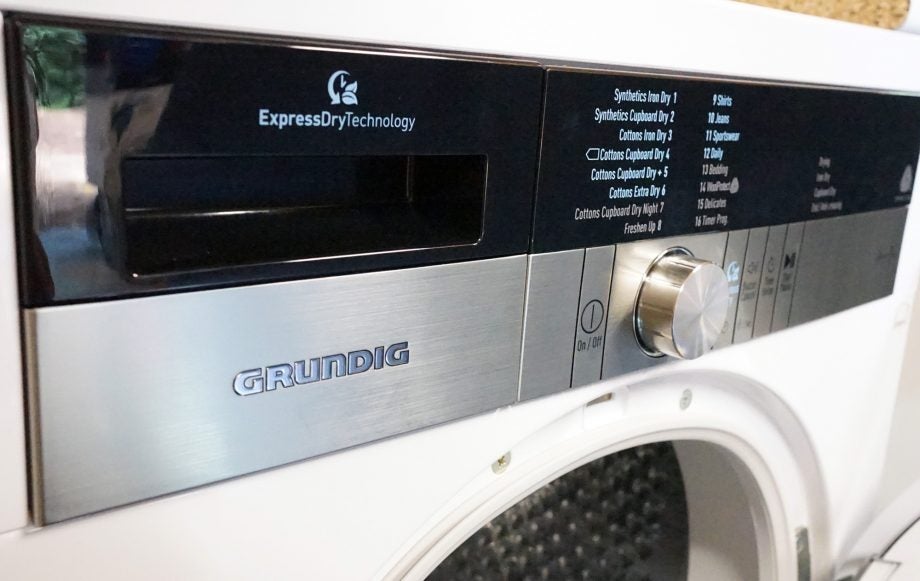
Verdict
Pros
- Fabulously low running costs
- Outstanding energy efficiency
- Huge drum
- Genuine 8kg capacity
- Simple, intuitive controls
Cons
- Limited drying levels
- Basic programme choice
- Buttons lack sensitivity
- Iron Dry a little too damp
- Not particularly quiet
- Quite pricey
Key Specifications
- Review Price: £649.00
- 8kg load
- Heat Pump technology
- A+++ Energy rating
- ExpressDry function
- 16 programmes
- Optional plumbed in waste
- Drum light
What is the Grundig GTN38267GCW?
Grundig’s latest heat-pump tumble dryer combines high-tech, energy-efficient drying with simple controls and a basic choice of programmes. It majors on practicality: the huge porthole opening and bright drum light being our favourites.
It isn’t the quietest tumble dryer we’ve tested, and – like the matching Grundig GWN59650CW washing machine – the touch controls can be a bit finicky. But the GTN38267GCW is simple to use, turns in great drying results and delivers super-low running costs.
Related: Best tumble dryers
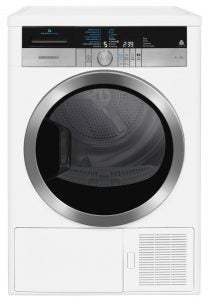
Grundig GTN38267GCW – Design and features
Styled to match Grundig’s equally modern-looking GWN59650CW washing machine, this heat-pump tumble dryer is crisp and sleek. The combination of glossy black plastic, crisp blue display and touch buttons on brushed stainless steel are classy, if something of a fingerprint magnet.
There are far fewer buttons on the tumble dryer, hinting at this machine’s ease of use. While the programme count is up there with the best at 16 in total, many of those are simply different drying levels for the same load. At this price, it’s short of non-essential, nice-to-have features – steam, for example – but it covers the basics well. The features it does have are easily accessed from the main dial and a couple of buttons.
At first sight, the one thing you won’t miss is that enormous door. It opens to reveal an epic-sized porthole that’s big enough to stuff in a double duvet without having to wrestle it in. Better still, as soon as the door opens, a bright white interior light comes on. Your smalls will never get lost in the deep recesses of the capacious 8kg drum.
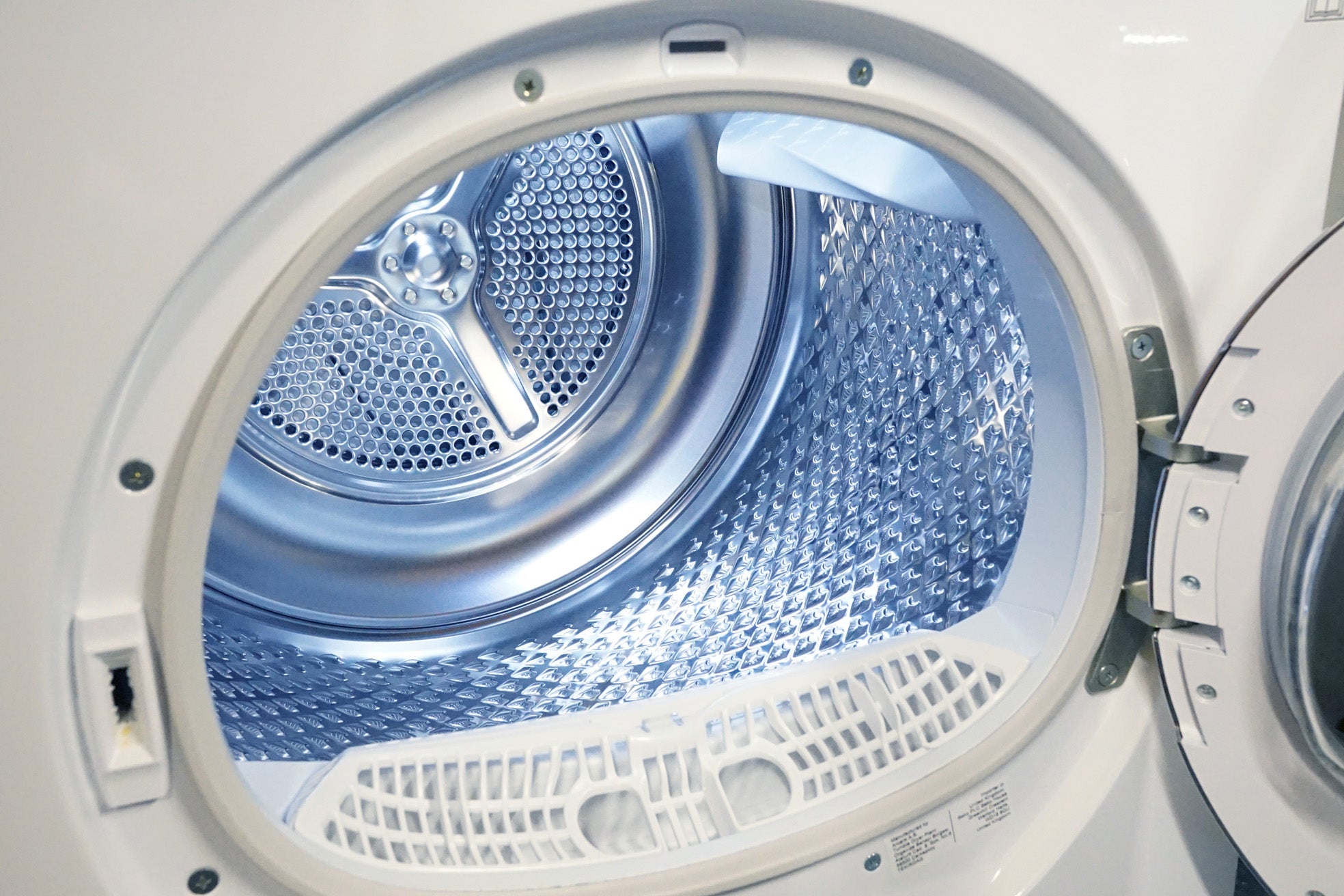
The front lower edge of the door frame is wide enough to encompass a large fluff filter. This simply pulls out and opens to allow you to de-fluff it between loads. We found fingers removed the lint from the filter gauze effectively enough, but you can clean it even more thoroughly with a damp cloth.
The lower condenser also has a fluff filter, strangely referred to as a ‘water filter’ in the manual. This is secreted behind a large flap beneath the door and has a release mechanism that looks like a set-prop from a science-fiction movie. Twist the lock and withdrawing the unit reveals a washable foam filter rather than di-lithium crystals, however.
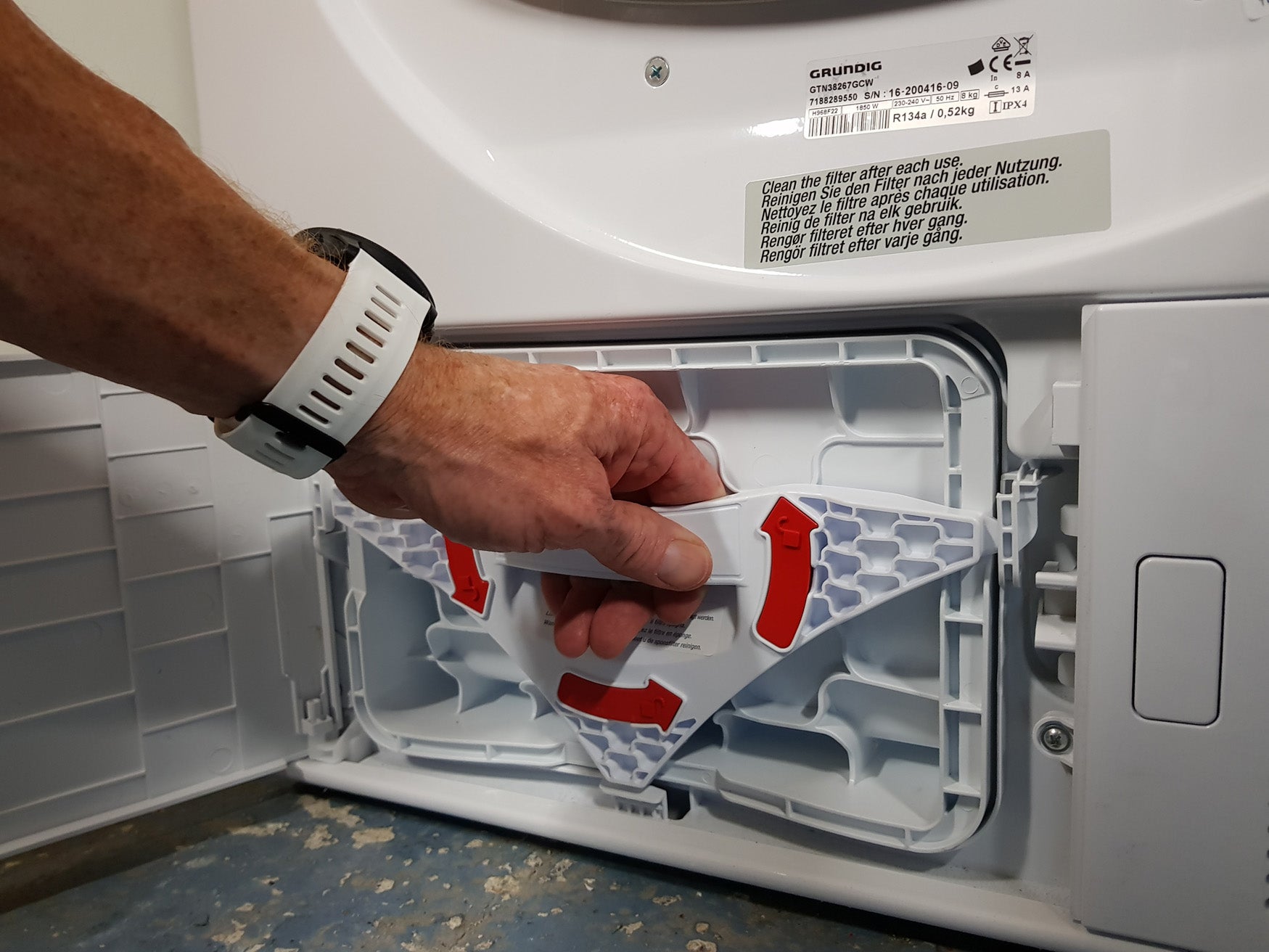
Both this filter and the main door filter trigger cleaning lights on the fascia when in need of attention. There’s also a light to indicate that the water tank is full. The tank is located as a pull-out container behind the drawer front; it slides out easily. If the machine is cited near waste plumbing in your kitchen, you can use the plumbing kit supplied to direct the water removed from your washing straight to the drain.
The GTN38267GCW is a full-sensor machine and the sizeable drum looks like it might happily take the full 8kg load claimed. It isn’t exactly bristling with extras and at £650 we’d have expected a few more frills. Arguably, though, if this machine’s performance lives up to its good size, energy promise and ease of use, it will still offer great value.
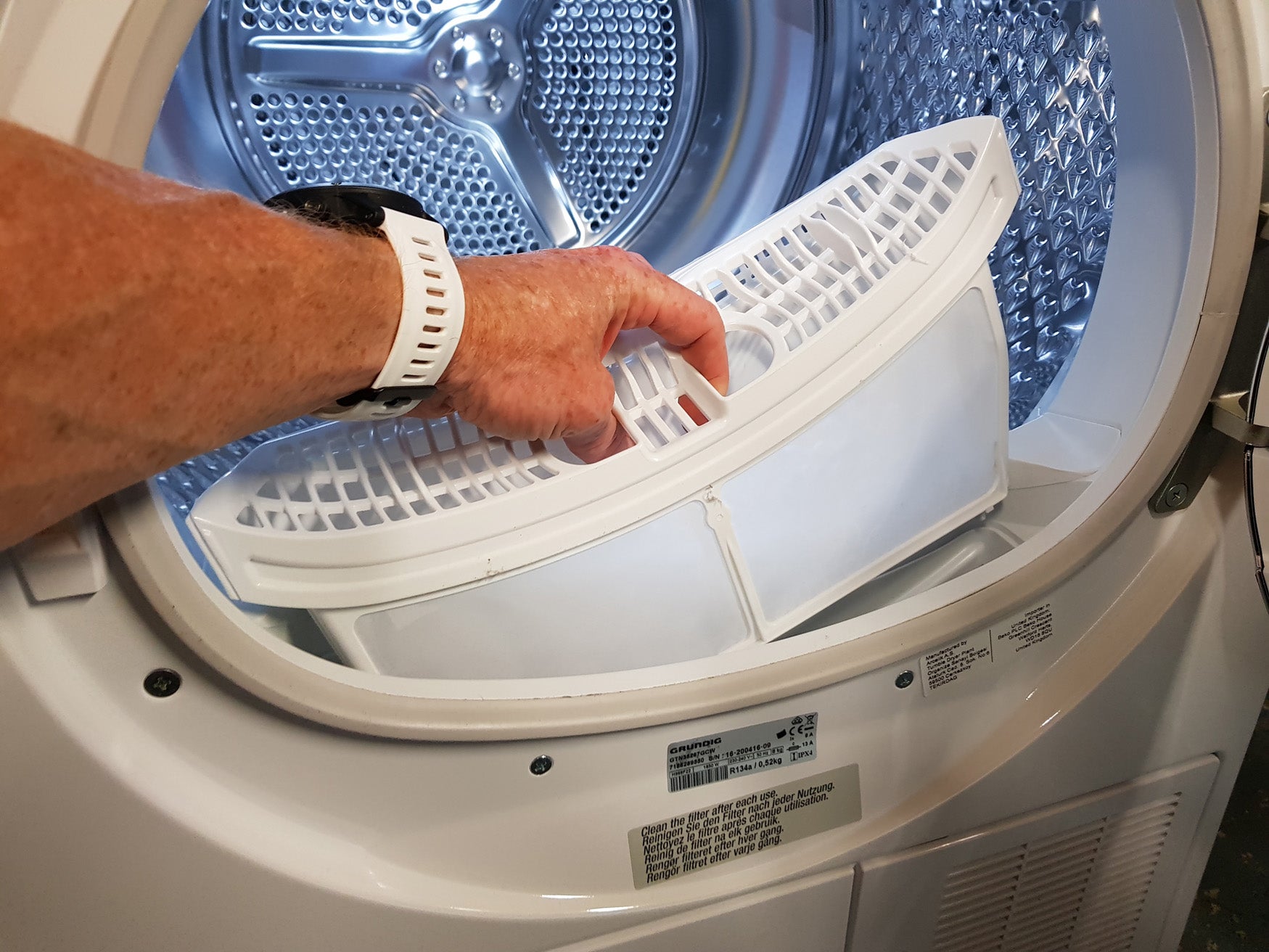
Grundig GTN38267GCW – What is it like to use?
Grundig has obviously spent much time ensuring that this machine is usable, even without having read the manual. The programme choice and selection is logical using the central knob, with the programme number displayed on its own blue display.
For the main programmes, the options are limited to a timed delay start, Express Dry speed-up function and the ability to cancel the buzzer that signals the end of the drying process. Insert washing, select a programme, press start/pause – it’s as simple as that.
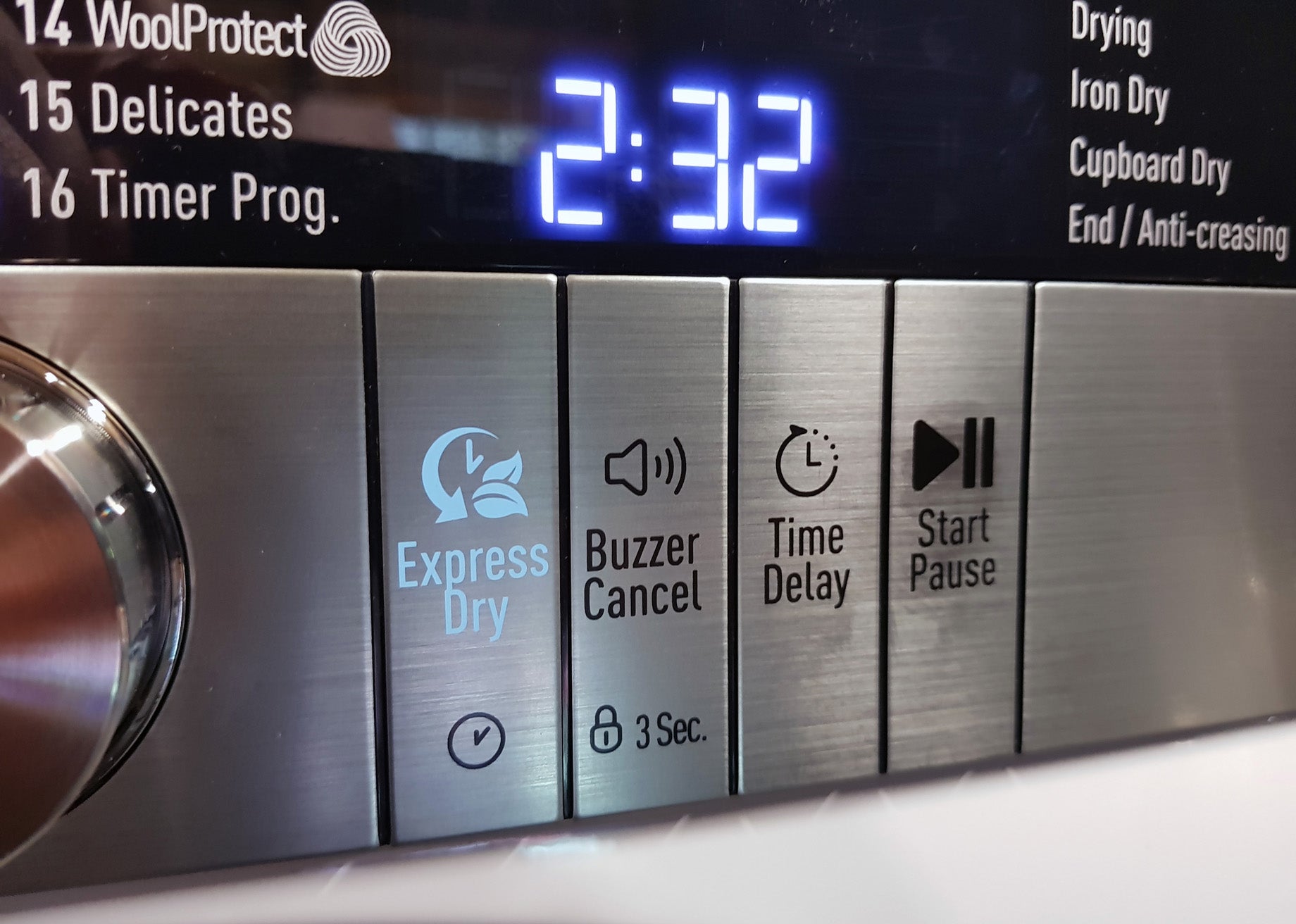
A marginally less vivid display counts down the time to finish the programme cycle. This display also hosts illuminated warning indicators for the filters, water tank and child lock. A post-dry anti-creasing cycle runs for two hours automatically, flipping your clothes every 10 minutes or so to keep them supple.
Our only gripe with the operation is the same one levelled at the matching washer: the touch controls aren’t sensitive enough. Sometimes they seem to require a light touch, at other times a firm finger press and hold for a fraction of a second. On quite a few occasions we found ourselves having to press the same button a couple of times to elicit a response.
This will cease to be a problem when you get used to the sort of touch required, but in general the buttons just aren’t as responsive as they could be. Ironically, this is more obvious against the Grundig’s overall ease of use.
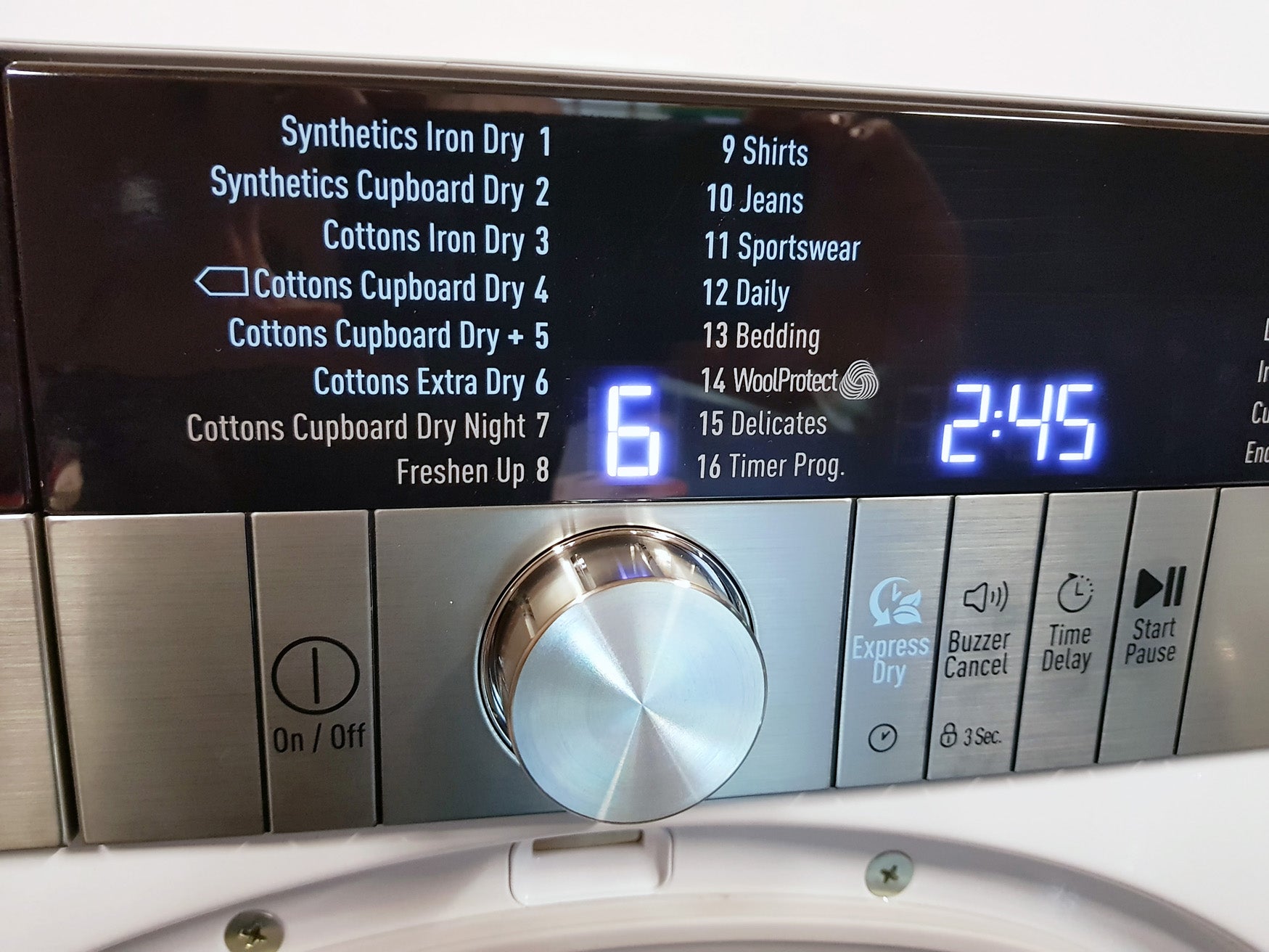
Grundig GTN38267GCW – How noisy is it?
If you’re looking for a super-hushed tumble dryer then this Grundig won’t be your best bet. The energy label suggests a fairly noisy 66dB, and in our tests it came in only a little lower at around 64dB.
By modern tumble drying standards that isn’t overly quiet. In the Grundig’s defence, the noise is a smooth and constant hum. The drum rotates in a single direction at constant speed, and as such we didn’t hear any of the more unusual metallic-sounding scrapes of the heat pump.
A dedicated Cotton Night programme reduces the noise output for drying in the wee small hours ‘by up to 50%’ claims Grundig’s manual. In practice, the noise was a few decibels quieter than the standard load programmes, but not enough to make the Grundig a natural night-time bedfellow.
The noise output isn’t bad, but at £650 for the GTN38267GCW we’d have expected a little quieter.
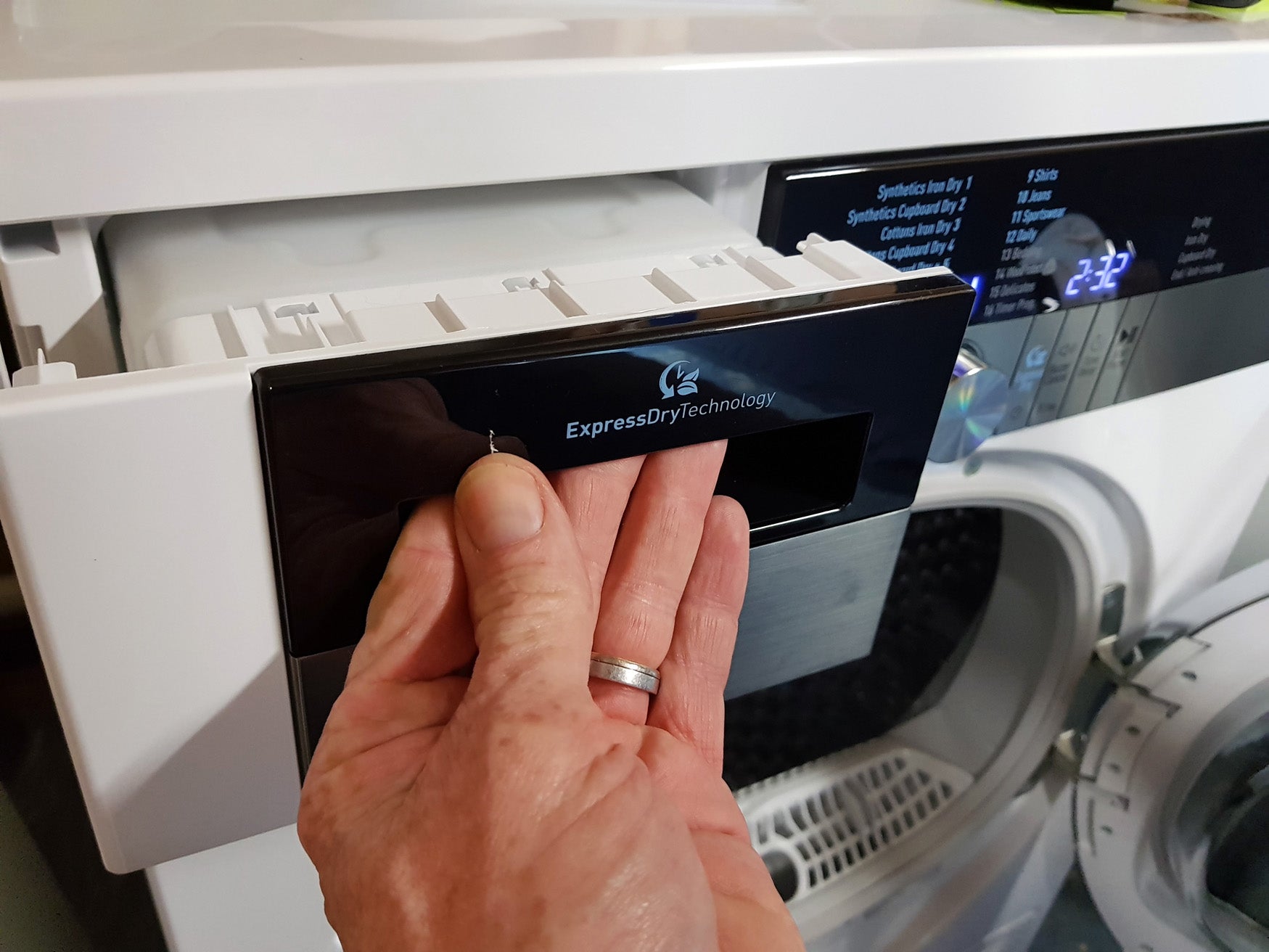
Grundig GTN38267GCW – What programmes does it have?
While much of the tumble drying market seems to have decided to compartmentalise loads into ever more specific sectors, this Grundig is refreshingly simple. While the headline figure states 16 programmes, there are in fact only 10 different material option programmes and a basic timer-only programme.
From power-up this machine defaults to programme number 4: Cottons Cupboard Dry. This is the most energy-efficient programme, and the one on which the A+++ energy rating is based. In fact, there are four other Cottons programmes that simply vary in dryness levels from iron dry to extra dry, and the reduced noise level night mode.
Synthetics also have two distinct programmes, divided into iron dry and cupboard dry. If you want your synthetics extra dry, you’re out of luck.
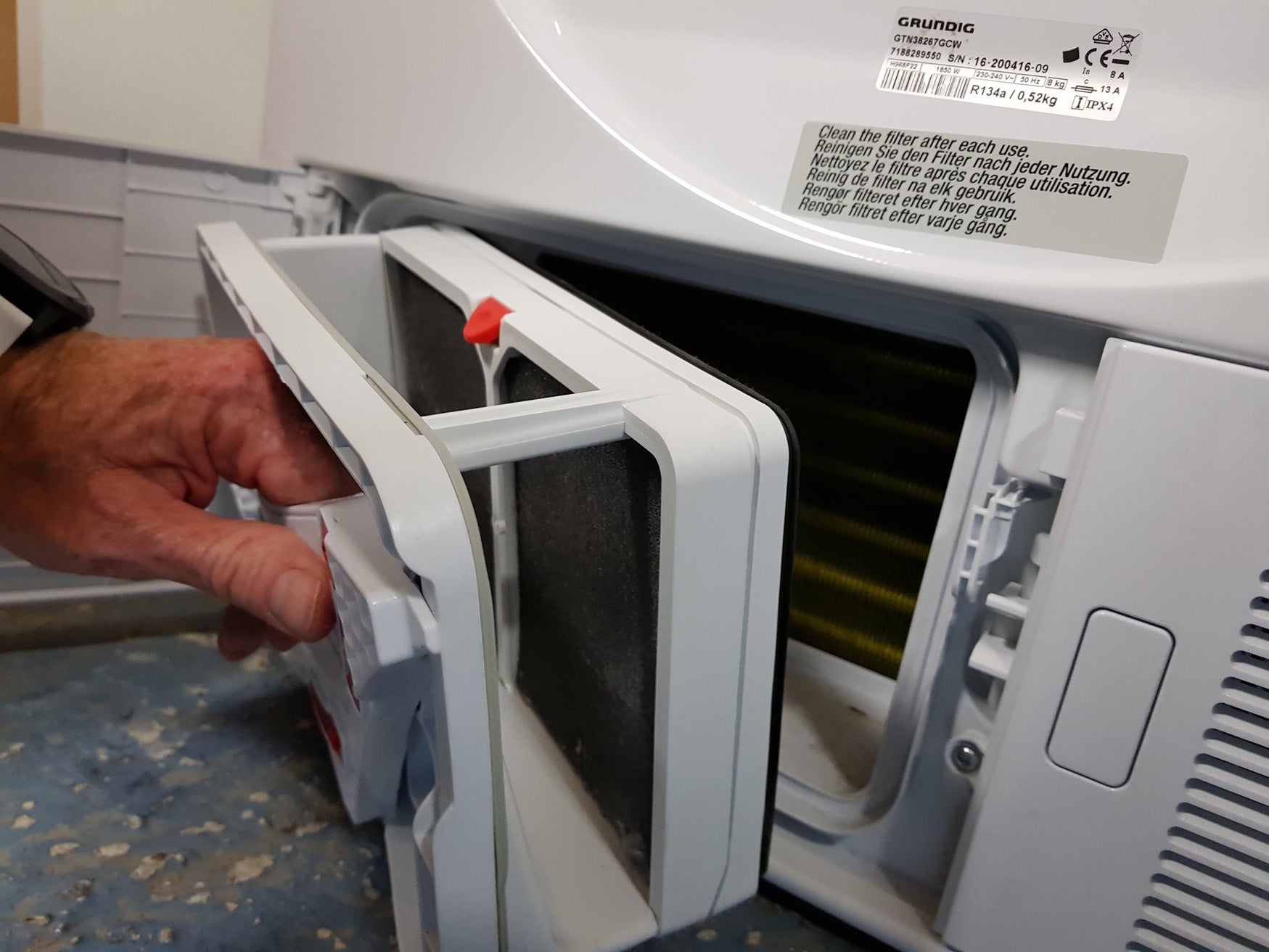
The specialist programmes aren’t great in number but they do cover a solid range of common materials and clothing types. Shirts, jeans, sportswear, bedding, delicates and wool are all catered for with varying maximum capacities depending on the programme. These range from a serious 4kg of sportswear to a rather more modest 1.5kg of shirts or woolly jumpers. You don’t have any control over how dry these loads will emerge from the drum, however.
You get a bedding programme designed to dry one double-sized quilt, and a 4kg mixed-materials programme slightly confusingly labelled ‘daily’. If your clothes need a quick breeze-through rather than drying, the Freshen Up cycle gives the load a 10-minute tumble in cool air.
Like most eco-friendly tumblers, drying times aren’t short. The default Cotton Cupboard Dry programmes comes in at over two and a half hours, for example. If you’re happy to throw a few more watts at the issue, the Express Dry option reduces the drying time – a bit. In the case of the standard cottons programme, by about 30 minutes.
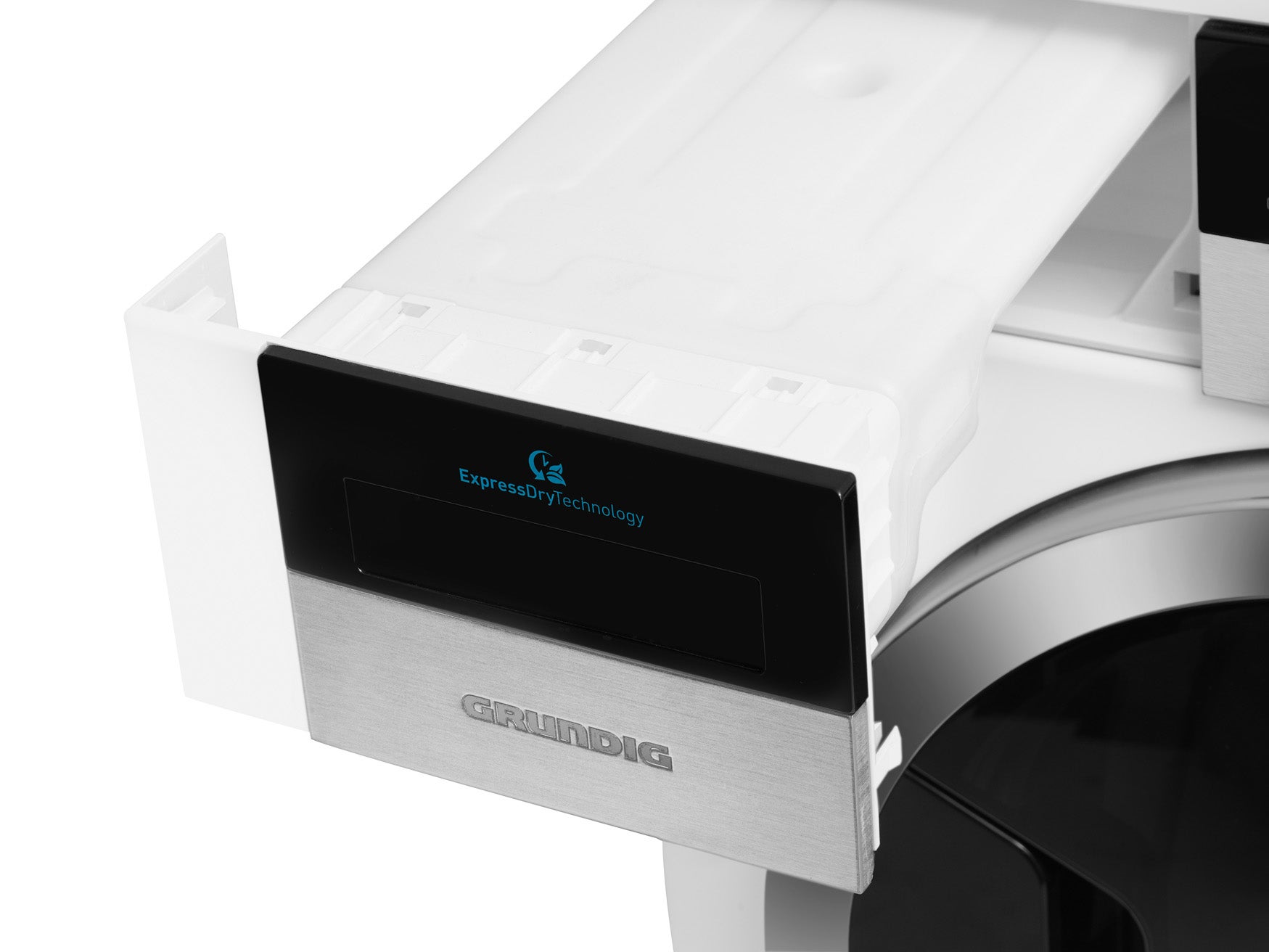
Grundig GTN38267GCW – How well does it dry?
While having specific programmes for different drying levels for cottons and synthetics simplifies general operation, it’s rather limiting on the secondary cycles. With no separate iron/cupboard/extra dry option on the specialist loads, you’re pretty much stuck with what the machine dictates is the correct level of dryness. That transpired to be what we’d term ‘cupboard dry’: neither too wet, nor so dry you get creases sharp enough to cut yourself.
We ran with our usual 80% of the max capacity load and the Grundig swallowed all 6.4kg of it. It was tight in the drum but it all went in. That’s more than can be said for a lot of 8kg models we’ve tested.
Using the default Cotton Cupboard Dry programme, this load took all of the originally indicated 2hrs 32mins to complete. With less than 70g of moisture remaining in the load (under 1% of dry weight), we’d class this as perfectly cupboard dry.
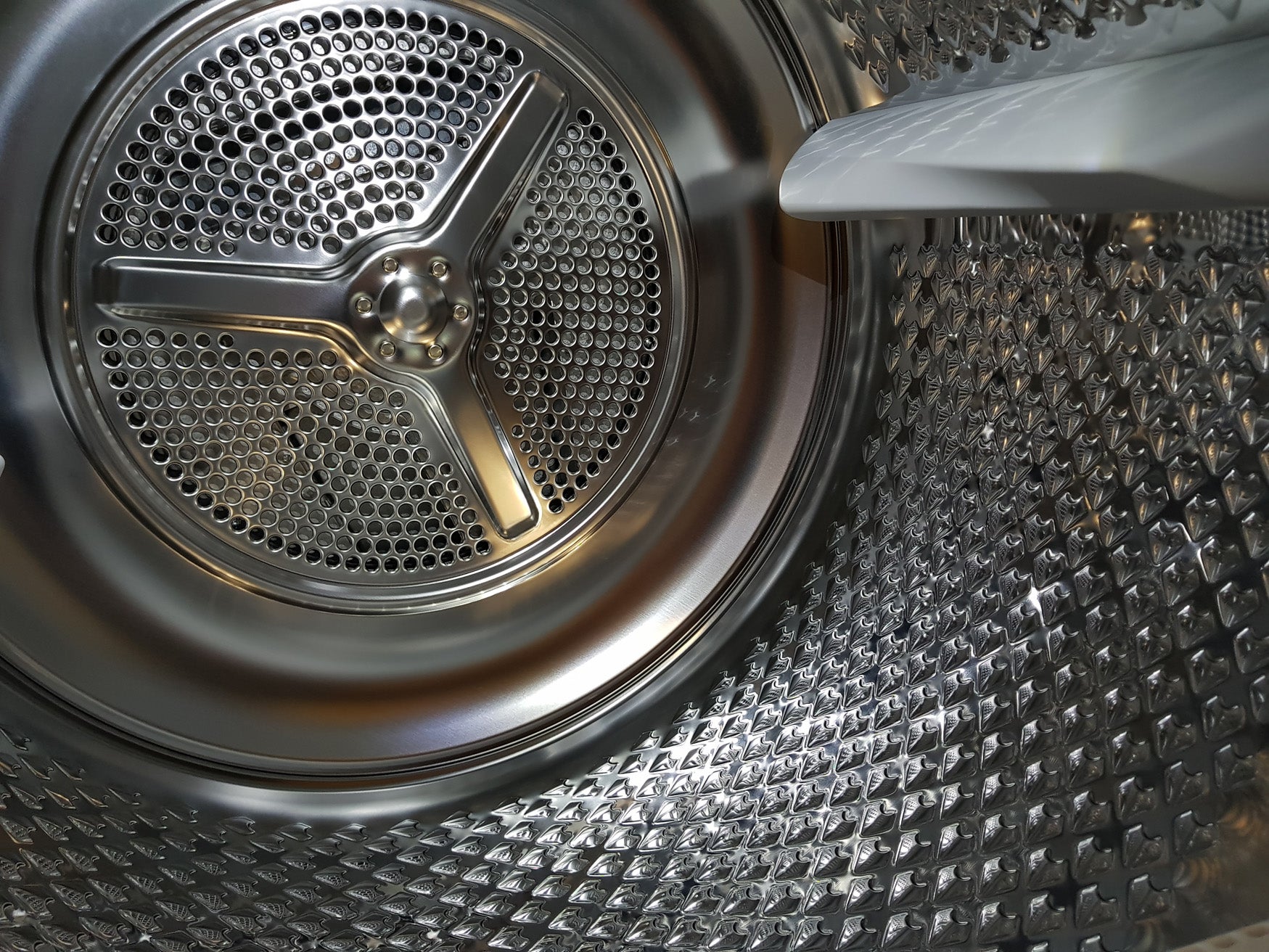
Rummaging through this huge load did reveal some typical anomalies associated with stuffing the drum to capacity, however. These included heavy cotton jeans feeling a little more damp than ideal for cupboard dry and some light cotton shirts taken to an extra dry/ zero percent moisture level. That meant they were more creased and trickier to iron than ‘cupboard dry’ would suggest.
Reducing the load to a rather more typical/sensible 4.5kg – which is still a huge load – saw this Grundig hit a real sweet spot for drying performance and energy efficiency. The sub 1% moisture was more consistent across the entire load and drying times were reduced. A great result.
We washed the same load again, spun in a 1400rpm spin machine, and repeated the drying on the Grundig’s Cotton Iron Dry cycle. The load was complete in under two hours but the results were still too damp in our opinion. The load had retained nearly 500g of moisture. While that made it easy to iron, the act of ironing didn’t serve to complete the drying process for heavier material garments such as jeans.
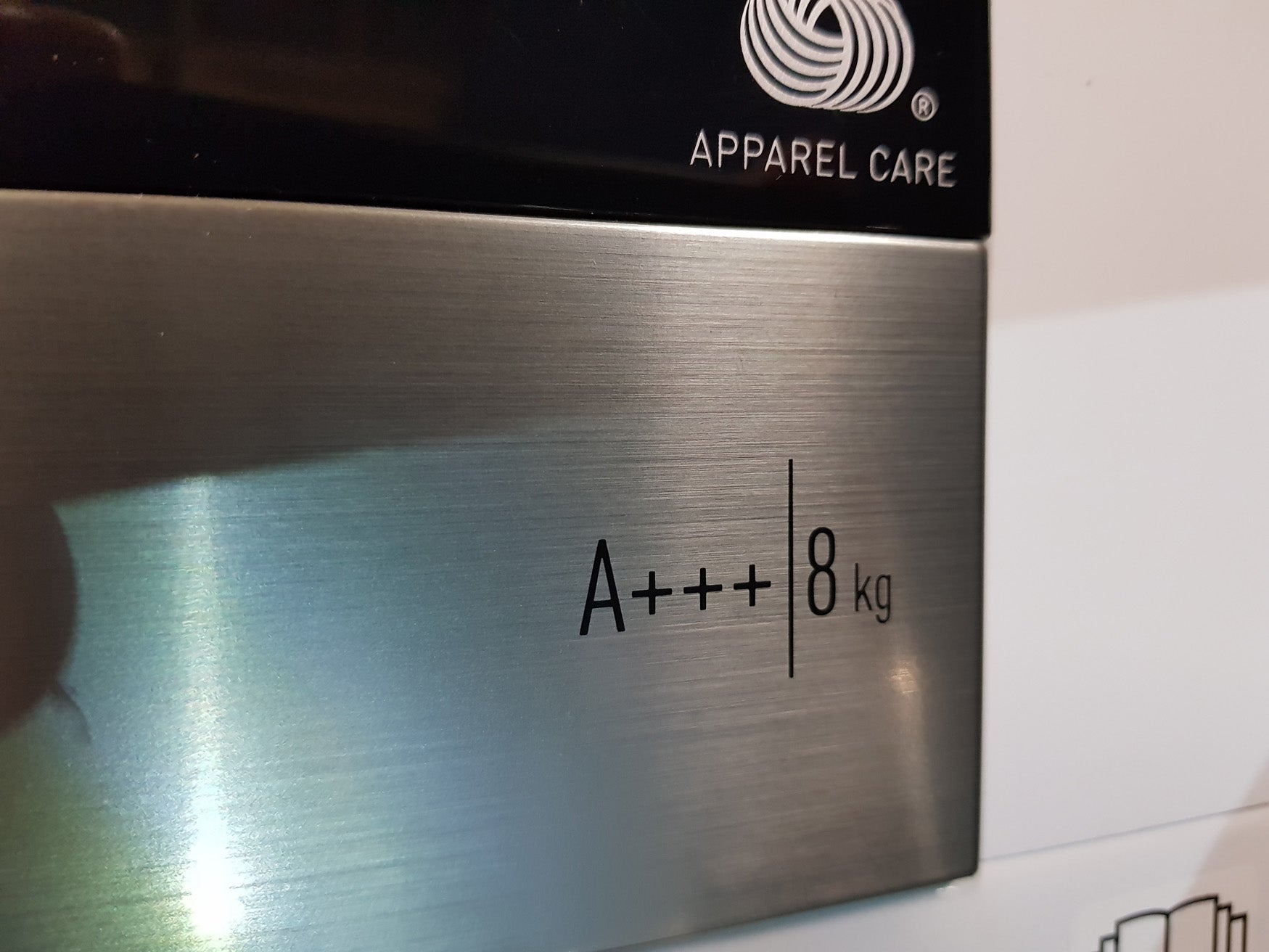
The same 4.5kg load on the Cottons Extra Dry programme delivered a perfect 0% moisture result in about 2hrs 45mins. The Express Dry function did as promised and reduced most full-load drying times by about 30 minutes. The end drying results and energy were similar. For full loads then you’d question why there would be a longer cycle in the first place? Still, since 30 minutes is hardly a huge saving on cycles up to three hours anyway, it’s probably a moot point.
The upshot of our tests is that this Grundig delivers some very good Cupboard Dry and Extra Dry results, even if its Iron Dry Cottons programme left the washing a little damper than ideal.
Grundig GTN38267GCW – How much will it cost to run?
Buying a heat-pump tumble dryer alone doesn’t ensure that your drying costs will be slashed. There are a lot of poorly implemented heat-pump designs out there that barely improve on the energy efficiency of a traditional heater element design. Not so with this superbly efficient Grundig GTN38267GCW.
More than living up to its A+++ billing on the Cotton Cupboard Dry default programme, it used an extremely frugal 0.65kWh of energy to dry our 4.5kg load to perfection. Better still, it used just a handful of watts more to complete the full 6.4kg load, even if the drying results through that load were a little more variable.
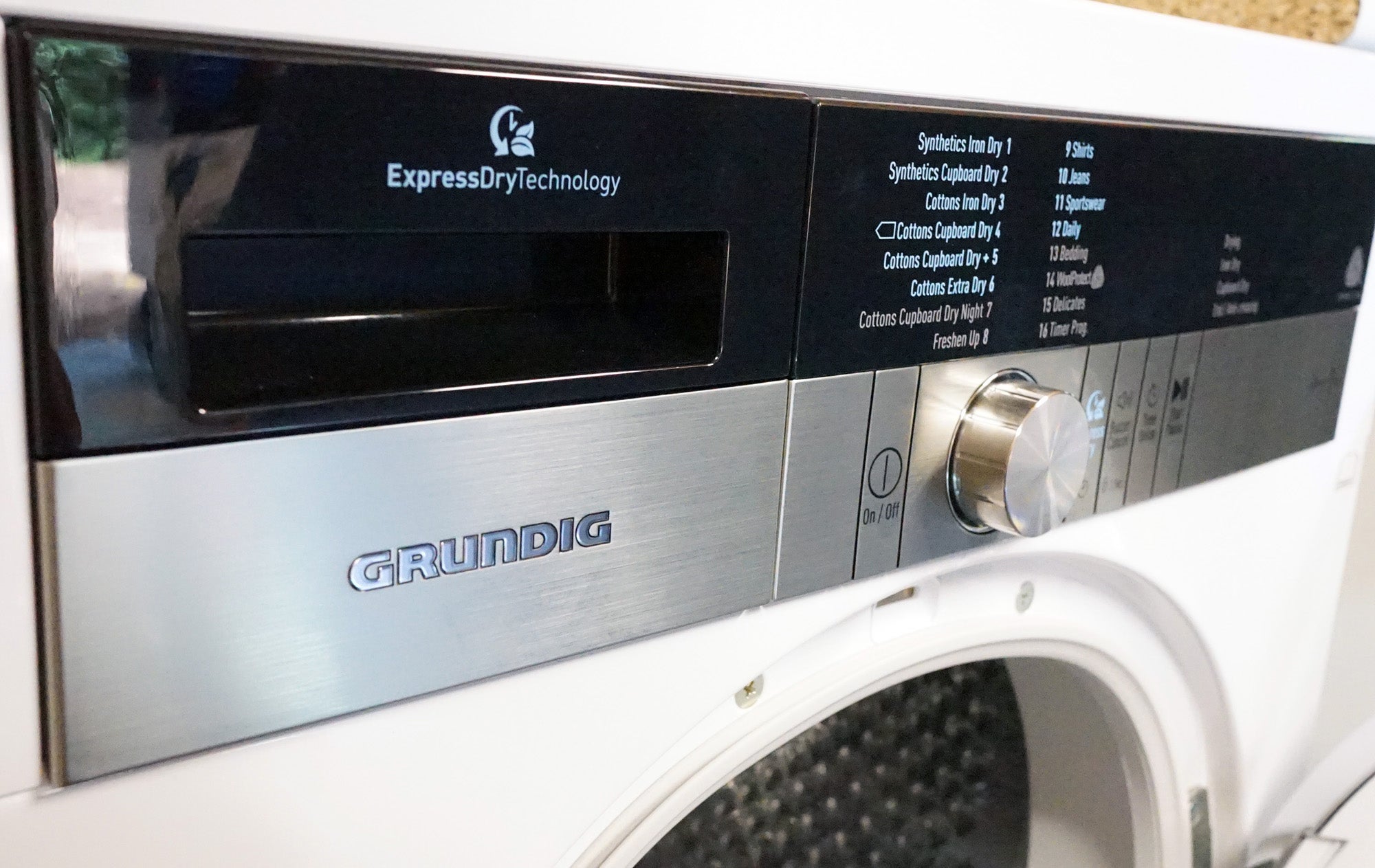
Looking at this another way: the smaller the load, the less energy-efficient this dryer is per kilogram of washing dried. It’s therefore at its best energy-wise with larger loads. To put this into perspective, an old-school heater element tumble dryer might use three or four times that amount of energy.
If you used this machine 150 times per year at 100 full loads (80% or 6.4kg to replicate real-world use) and 50 small loads up to 3.2kg on the default Eco Cottons programme, it would use around 100kWh. At 15p/kWh, that’s just £15 a year – a spectacularly good result.
Given that regime would see 800kg of clothing dried over the course of the year, this Grundig turns in the lowest drying cost per kilogram we’ve seen. And by quite a margin too! This machine has really maximised the energy benefits of heat pump technology and done so with great drying results.
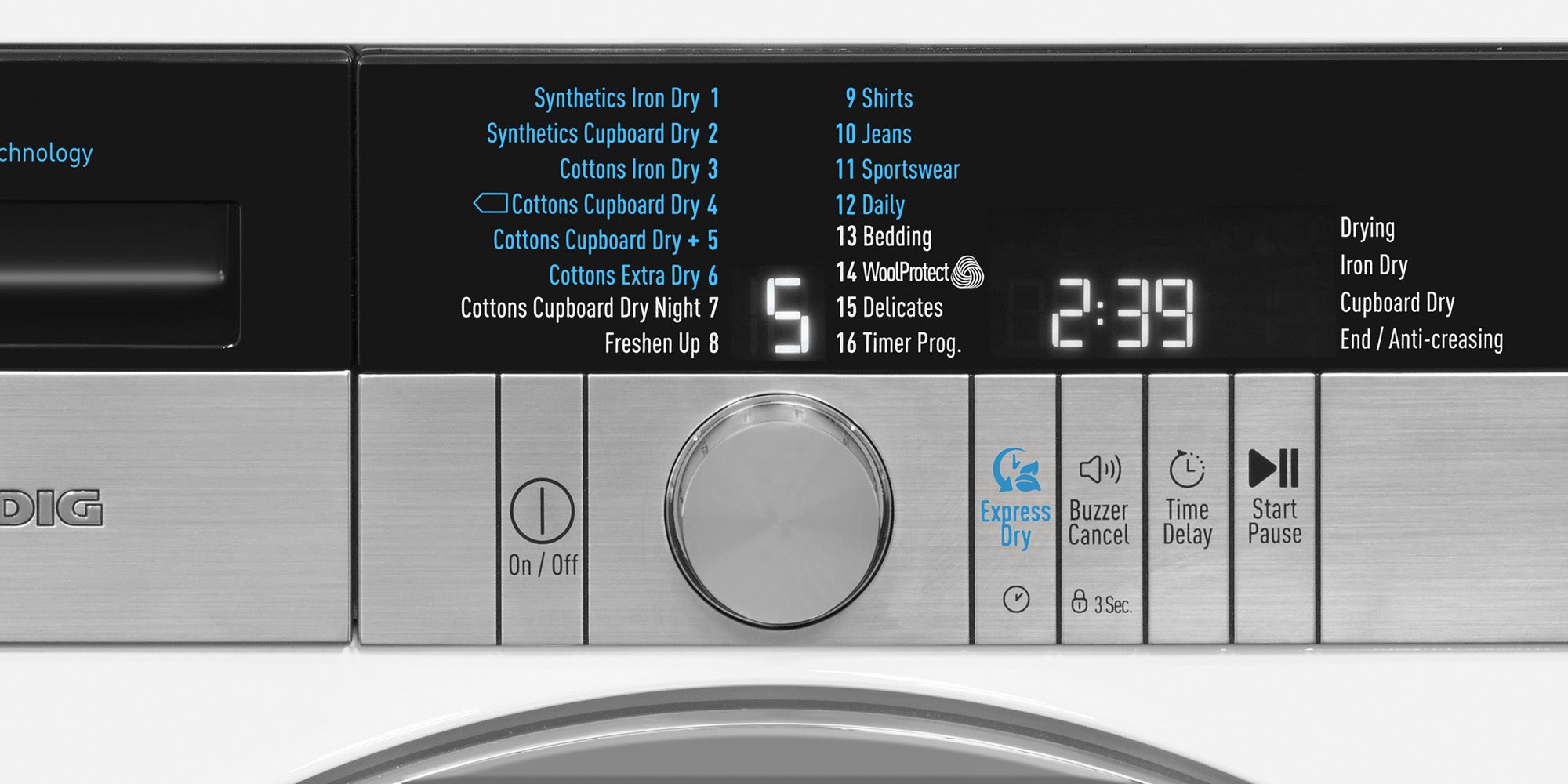
Should I but the Grundig GTN38267GCW?
Offering the lowest drying costs per kilogram of clothing we’ve yet seen, Grundig’s GTN38267GCW is a super-efficient heat-pump dryer that delivers superb drying results. Operation is straightforward, nice touches include the drum light, and it even dried a genuine full load in our tests.
We don’t like the lack of user-defined drying levels for specialist loads, programmes and options are limited, and the touch control buttons can be a bit hit and miss. All that makes the £650 asking price look a little steep. Nevertheless, for basic clothes drying with the lowest tumble drying running costs currently available, the GTN38267GCW is star performer.
Related: Best washing machines
Verdict
Grundig’s GTN38267GCW mixes basic programmes and frill-free operation with great drying performance and spectacularly low energy consumption.
Trusted Score
Other
| Power Consumption (KWh) | 0.65 |
| Cost Per Load at 15p/KWh | 10p |
| Remaining Moisture (Grams / % of load) | 50g/under 1% |
| Time to Completion | 2hrs 32mins |
| Max Noise | 64dB |
| Cupboard Dry Accuracy | Perfect |
General Info
| Drum Capacity | 8kg |
| Energy Rating | A+++ |
| Approx. Annual Power Consumption (KWh) | 100 |
| Approx. Annual Running Cost | £15 |
50% Mixed Dry Load / 'Cupboard Dry'
| Power Used (KWh) | 0.60 |
| Running Cost per Load at (15p/KWh) | 9p |
| Moisture Remaining (Grams / % of load) | 24g/under 1% |
| 'Cupboard Dry' Accuracy | Perfect |
| Time to Finish | 2hrs 20mins |
| Noise Max Spin | 64dB |


